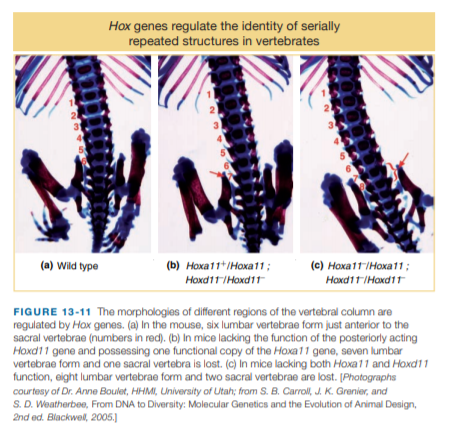Hox genes regulate the identity of serially repeated structures in vertebrates (a) Wild type (b) Ноха11*/Ноха11%; (c) Hoxa11-IHoxa11; Hoxd11IHoxd11 Haxd11IHaxd11 FIGURE 13-11 The morphologies of different regions of the vertebral column are regulated by Hox genes. (a) In the mouse, six lumbar vertebrae form just anterior to the sacral vertebrae (numbers in red). (b) In mice lacking the function of the posteriorly acting Hoxd11 gene and possessing one functional copy of the Hoxa11 gene, seven lumbar vertebrae form and one sacral vertebra is lost. (c) In mice lacking both Hoxa11 and Hoxd11 function, eight lumbar vertebrae form and two sacral vertebrae are lost. [Photographs courtesy of Dr. Anne Boulet, HHMI, University of Utah; from S. B. Carroll, J. K. Grenier, and S. D. Weatherbee, From DNA to Diversity: Molecular Genetics and the Evolution of Animal Design, 2nd ed. Blackwel, 2005.)
Hox genes regulate the identity of serially repeated structures in vertebrates (a) Wild type (b) Ноха11*/Ноха11%; (c) Hoxa11-IHoxa11; Hoxd11IHoxd11 Haxd11IHaxd11 FIGURE 13-11 The morphologies of different regions of the vertebral column are regulated by Hox genes. (a) In the mouse, six lumbar vertebrae form just anterior to the sacral vertebrae (numbers in red). (b) In mice lacking the function of the posteriorly acting Hoxd11 gene and possessing one functional copy of the Hoxa11 gene, seven lumbar vertebrae form and one sacral vertebra is lost. (c) In mice lacking both Hoxa11 and Hoxd11 function, eight lumbar vertebrae form and two sacral vertebrae are lost. [Photographs courtesy of Dr. Anne Boulet, HHMI, University of Utah; from S. B. Carroll, J. K. Grenier, and S. D. Weatherbee, From DNA to Diversity: Molecular Genetics and the Evolution of Animal Design, 2nd ed. Blackwel, 2005.)
Biology: The Dynamic Science (MindTap Course List)
4th Edition
ISBN:9781305389892
Author:Peter J. Russell, Paul E. Hertz, Beverly McMillan
Publisher:Peter J. Russell, Paul E. Hertz, Beverly McMillan
Chapter50: Animal Development
Section: Chapter Questions
Problem 14TYK
Related questions
Question
As shown in Figure 13-14, what is the fundamental distinction between a pair-rule gene and a segment-polarity
gene?

Transcribed Image Text:Hox genes regulate the identity of serially
repeated structures in vertebrates
(a) Wild type
(b) Ноха11*/Ноха11%;
(c) Hoxa11-IHoxa11;
Hoxd11IHoxd11
Haxd11IHaxd11
FIGURE 13-11 The morphologies of different regions of the vertebral column are
regulated by Hox genes. (a) In the mouse, six lumbar vertebrae form just anterior to the
sacral vertebrae (numbers in red). (b) In mice lacking the function of the posteriorly acting
Hoxd11 gene and possessing one functional copy of the Hoxa11 gene, seven lumbar
vertebrae form and one sacral vertebra is lost. (c) In mice lacking both Hoxa11 and Hoxd11
function, eight lumbar vertebrae form and two sacral vertebrae are lost. [Photographs
courtesy of Dr. Anne Boulet, HHMI, University of Utah; from S. B. Carroll, J. K. Grenier, and
S. D. Weatherbee, From DNA to Diversity: Molecular Genetics and the Evolution of Animal Design,
2nd ed. Blackwel, 2005.)
Expert Solution
This question has been solved!
Explore an expertly crafted, step-by-step solution for a thorough understanding of key concepts.
Step by step
Solved in 2 steps

Knowledge Booster
Learn more about
Need a deep-dive on the concept behind this application? Look no further. Learn more about this topic, biology and related others by exploring similar questions and additional content below.Recommended textbooks for you

Biology: The Dynamic Science (MindTap Course List)
Biology
ISBN:
9781305389892
Author:
Peter J. Russell, Paul E. Hertz, Beverly McMillan
Publisher:
Cengage Learning

Biology: The Dynamic Science (MindTap Course List)
Biology
ISBN:
9781305389892
Author:
Peter J. Russell, Paul E. Hertz, Beverly McMillan
Publisher:
Cengage Learning